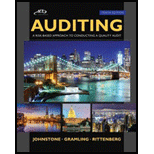
a.
Introduction: Auditing means the inspection of financial accounts of the company to determine if the records are accurate as per the rules and regulations of accounting or not. There are two types of auditors, i.e., internal auditors and external auditors, that carry out the
To describe:The unethical action that was taken by SB.
b.
Introduction:Auditing means the inspection of financial accounts of the company to determine if the records are accurate as per the rules and regulations of accounting or not. There are two types of auditors i.e. internal auditors and external auditors, that carry out the auditing process.
To compare:Independence in Fact and Independence in Appearance in light of the given case.
c.
Introduction: Auditing means the inspection of financial accounts of the company to determine if the records are accurate as per the rules and regulations of accounting or not. There are two types of auditors i.e. internal auditors and external auditors, that carry out the auditing process.
To comment:On the punishments faced by S.
Trending nowThis is a popular solution!

Chapter 1 Solutions
Auditing: A Risk Based-Approach to Conducting a Quality Audit
- Some criticize the accounting profession for using expressions in the audit report that seem to be building in deniability should the client commit a fraudulent act. What expressions enable the CPA to build a defense should the audit wind up in the courtroom? Do you see anything wrong with these expressions from an ethical point of view?arrow_forwardAssume that you accept the following ethical rule: “Failure to tell the whole truth is wrong.” In the textbook illustration about Santos’s problem with Ellis’s instructions, (a) what would this rule require Santosto do and (b) why is an unalterable rule such as this classified as an element of imperative ethical theory?arrow_forwarda. What is the relationship between a. the ethical obligation of honesty and truth telling?b. Is it ever proper to not tell someone something that he or she has an expectation of knowing? If so, describe under what circumstances this might be the case. How does this square with rights theory?arrow_forward
- Utilitarianism does not require which of the following actions when a person considers how to resolve an ethical dilemma? a. Identification of the potential problem and courses of action. b. Identification of the potential direct or indirect impact of actions on each affected party who has an interest in the outcome. c. Identification of the motivation of the person facing the ethical dilemma. d. Assessment of the desirability of each action for each affected party.arrow_forwardAnswer the following based on the image of the scenario A-Help management understand the issue from Jack’s perspective. Describe the ethical dilemma that Jack faces. What is the issue? Who are the parties involved? If you were Jack, what would you consider when making a decision? B-Help management understand the elements of the fraud triangle in this situation which increase the chances of fraud. Why is this fraud? What are the opportunities, motivations and rationalizations that you see? How does this affect the business financially? C-Help management come up with a plan to minimize the likelihood of this happening in the future. Be sure to mention specific components of the COSO framework.arrow_forward
 Auditing: A Risk Based-Approach to Conducting a Q...AccountingISBN:9781305080577Author:Karla M Johnstone, Audrey A. Gramling, Larry E. RittenbergPublisher:South-Western College Pub
Auditing: A Risk Based-Approach to Conducting a Q...AccountingISBN:9781305080577Author:Karla M Johnstone, Audrey A. Gramling, Larry E. RittenbergPublisher:South-Western College Pub Auditing: A Risk Based-Approach (MindTap Course L...AccountingISBN:9781337619455Author:Karla M Johnstone, Audrey A. Gramling, Larry E. RittenbergPublisher:Cengage Learning
Auditing: A Risk Based-Approach (MindTap Course L...AccountingISBN:9781337619455Author:Karla M Johnstone, Audrey A. Gramling, Larry E. RittenbergPublisher:Cengage Learning- Business/Professional Ethics Directors/Executives...AccountingISBN:9781337485913Author:BROOKSPublisher:CengageBusiness Its Legal Ethical & Global EnvironmentAccountingISBN:9781305224414Author:JENNINGSPublisher:Cengage




